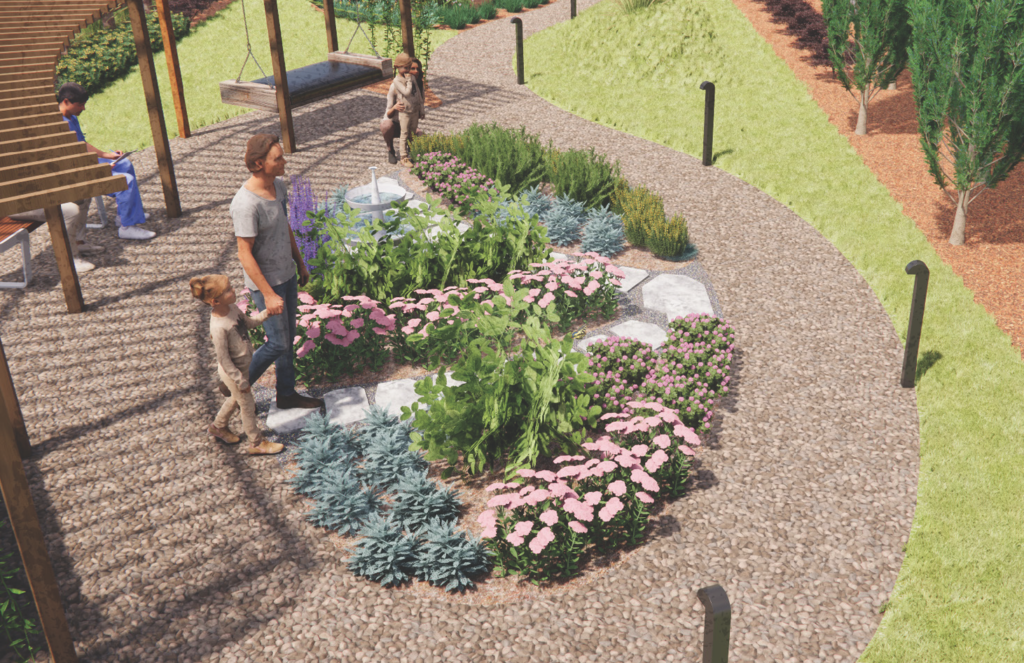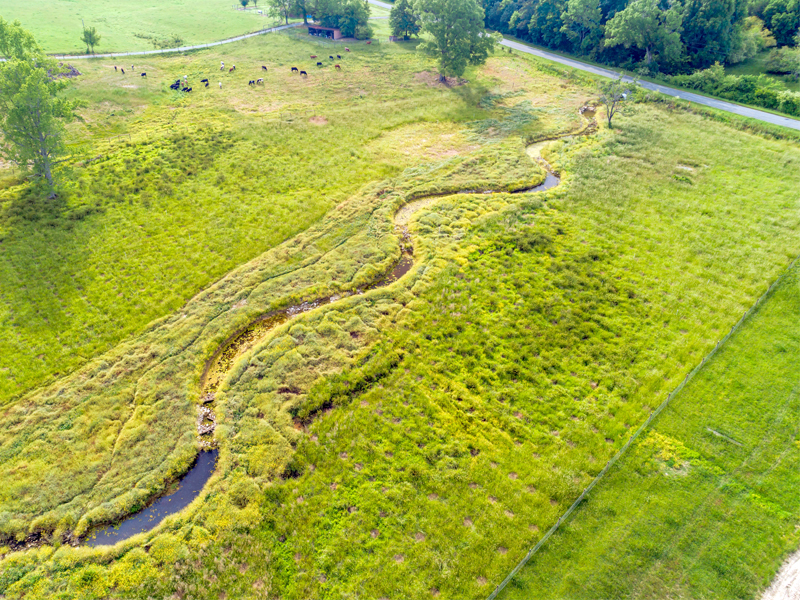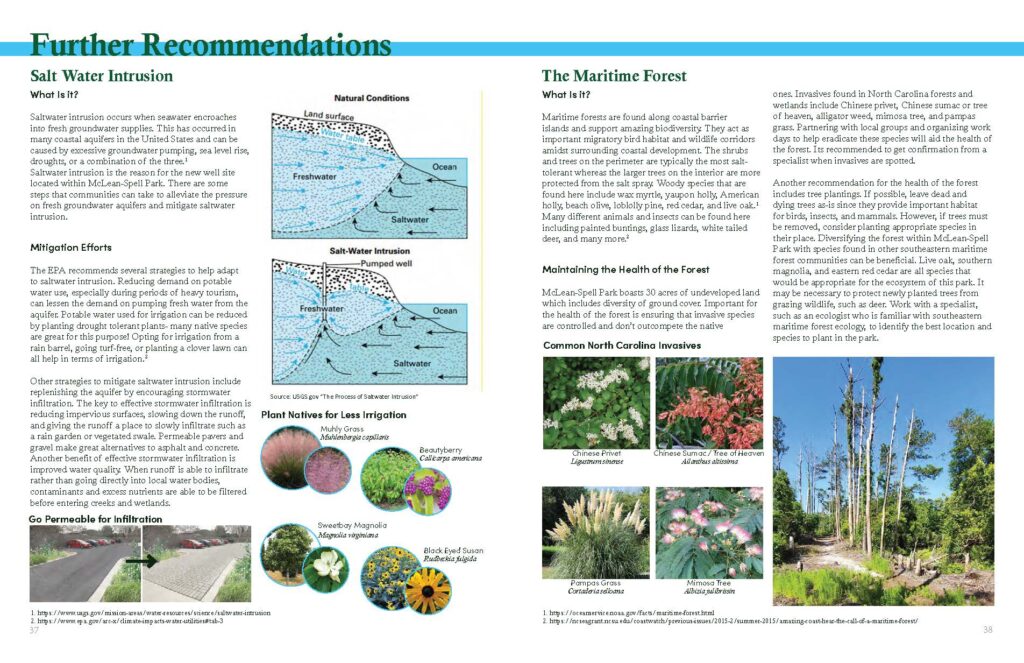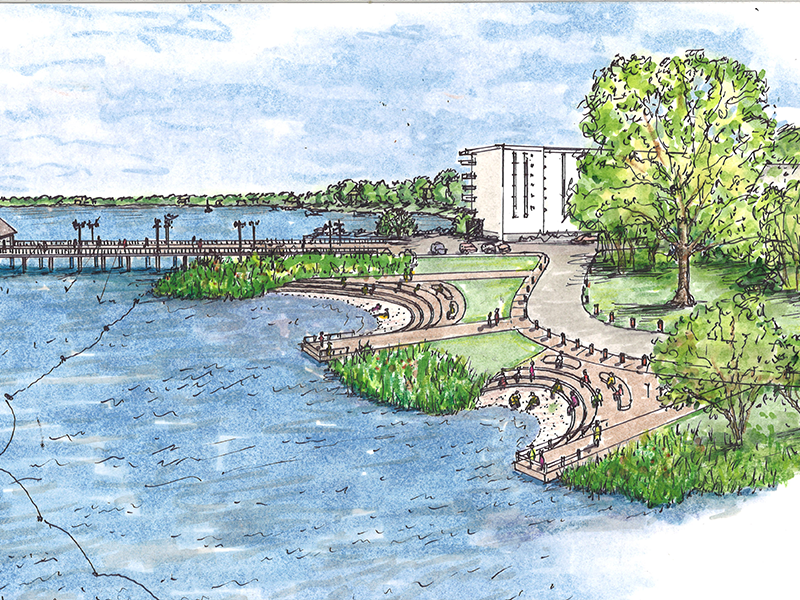The Sustainable Park and You
Consider, for a moment, your mental image of a park.
Perhaps your park has playgrounds for children, or covered pavilions to host gatherings. Perhaps it has nature trails, local water features, or plenty of shade to provide a break from the sun. Some parks have sport amenities; others may offer educational opportunities along a trail. Something they all have in common? They’re a little piece of nature for everyone to enjoy.
Historically, parks have been seen as havens from the city, where people could go to escape pollution, noise, and stress to instead engage in healthy physical and social activity. Today, a good park is able to provide all of these features and more, benefiting not only the health and wellbeing of a given population but also the environment. In previous blogs, we’ve discussed both the numerous benefits parks bring to communities as well as the numerous techniques Summit’s Landscape Architects use to create them. But when we’re building these communal spaces, it’s important to ensure that care and consideration is given towards making the space safe, accessible, and sustainable, so that future generations can benefit from these community assets.
But what is a sustainable park, and what does a sustainable park look like? Though there is no fixed definition, sustainable development has best been defined as “development that meets the needs of the present without compromising the ability of future generations to meet their own needs.” (World Commission on the Environment and Development). Lack of space, increased weather pattern intensity, and depleted resources have shifted the conversation around sustainability, elevating its importance from ‘ideal’ to ‘necessary’ as our communities look towards combating climate change.
The Principles of Sustainable Park Design
The concept of sustainable design is a relatively new one in the world of architecture. Much of the progress and consideration made towards sustainability has been made in the last 30 years. Because of this, best practices are still being refined as we learn more about our world and the materials we can use to sustain it.
Though the principles of sustainable park design are not fixed, early sustainable park objectives and goals that are still in practice today are:
- Minimizing adverse effects on environmental and cultural resources;
- Maintaining and encouraging biodiversity;
- building and operating facilities and amenities using energy-efficient materials and building techniques;
- demonstrating and promoting conservation principles and practices.
As our understanding of environmental stewardship and sustainability has evolved, numerous other ecological design principles have emerged, including:
- Prioritizing native plants that are adapted to the local climate and soil conditions;
- Centering water management to preserve water quality and recharge groundwater;
- Using renewable energy sources for generating electricity;
- Using recycled and locally sourced materials, when possible;
- Designing with community engagement and education in mind.
Sustainability is cultivated through various techniques and tools, from utilizing native plants to maintain and promote biodiversity to reducing rainwater runoff through permeable pavements. There is also an understanding that sustainability doesn’t begin and end with the materials used to create parks; educating the community about best practices, from protecting wild spaces to reducing waste, helps foster a sense of stewardship over the environment, which helps with conservatory efforts.

Lake Rogers Park Boardwalk in Creedmoor, NC
Accessibilities’ Role in Sustainable Park Design
In order for a park to be truly sustainable, it must also be accessible. A sustainable park without accessibility will result in a park that is a poor fit for the community.
Environmentally friendly parks should be in walkable areas easily reached by public transportation or other environmentally friendly means, such as biking. The goal is to encourage people to spare their cars a trip. The harder it is to get to a park without a car, the less likely people will use it, and the more burdensome the ecological cost of reaching the park will be. Overall, the best place for a park is where the most people can reach it with the least amount of effort.
It is also important to remember that parks are for everyone, and they need to maintain a large variety of purposes and facilities to service their community. For a park to be truly accessible, the diversity of its community must be accounted for in the design. The placement of buildings, pavilions, parking lots, and other structures should account for the natural spaces present in the park and be easy to use by park-goers to promote activity, wellness, and a sense of stewardship.
Environmental Benefits of a Sustainable Park
Parks—and especially urban parks—play a crucial role in establishing a place for conservation and environmental stewardship. One of your local park’s most important jobs is not only to provide a safe place for leisure and outdoor activities, but
When a sustainable park is established, some of the benefits include:
- Sequestering carbon dioxide and improving air quality;
- Reducing pollutants and sediment runoff from storms;
- Replenishing aquifers with freshwater;
- Protecting natural wildlife habitats;
- Promoting natural biodiversity and providing places for native plants, animals, and insects to flourish;
- Lowering the ambient temperature of nearby neighborhoods;
But how does it accomplish this? There are many innovations that help assist in these efforts.
How Sustainable Parks Improve Air Quality & Lower Temperatures
Trees and vegetation the world over are one of the primary combatants of air pollution. They do this by directly capturing pollutants in the air, such as carbon monoxide, CO2, ozone, nitrogen dioxide, and more. In fact, trees are so good at capturing pollutants that it is estimated that the annual pollutants removed by trees within urban parks is estimated to be over 75,000 tons—an average of 80 pounds of pollutants per acre of tree coverage. That’s the equivalent of over $500 million per year in pollutant removal!
Even small parks play their part in cleaning the air. While a small park may only capture about 160 cars worth of emissions per year, that park is working in concert with hundreds of others throughout the country. By investing in green spaces throughout our communities, we are investing in cleaner, cooler air for all to enjoy.
Furthermore, plants are helpful when it comes to cooling down—literally. This is especially important in urban areas, where “heat islands” created by infrastructure such as parking lots raise the ambient temperature significantly. This is why urban spaces are often so much warmer than their rural neighbors. Green spaces can mitigate this effect through a process called “transpiration,” where vegetation absorbs solar radiation and releases water vapor, cooling the surrounding air. Shade from trees can also protect visitors from harmful over-exposure to UV rays. Excessive exposure to UV is a contributing factor to several cancers, cataracts, and other medical concerns.
Sustainable parks, therefore, should strive to include significant tree coverage and vegetation to promote cleaner air and cooler temperatures. This can be accomplished through measures such as designing a variety of land coverage (from dense trees to scattered shade and lawns), sustaining existing tree coverage, and using long-lived native plants to populate parks.

Photo of the wetlands in the NC Wetlands Park
How Sustainable Parks Prevent Runoff & Replenish Aquifers
Cities are dense with hard, impermeable surfaces, such as roads, sidewalks, and buildings that shed rainwater and prevent it from being absorbed back into the ground. This is a large contributor to both flooding and water pollution. When rainwater lands on impermeable surfaces, such as asphalt, it carries pollutants such as trash and harmful chemicals on the surface with it when it runs into local bodies of water. When water cannot be absorbed into its environment, it may also cause a flood as the rainwater flows along roads and sidewalks. With nowhere to go, this water can damage infrastructure and cause nearby water sources to overflow their banks, flooding neighborhoods.
Parks can be a victim to this flooding, too. Older parks may see damage to amenities and natural resources alike when a flood event occurs, sometimes resulting in costly repairs and restorations. Soil in parks is also often compacted by everyday use, preventing proper filtration and rainwater penetration. However, parks are also a great place to combat this flooding through the proactive inclusion of sustainable and resilient engineering.
Some of the ways we can create sustainable parks is through the inclusion of features such as rain gardens, porous (or permeable) pavements, naturalized infiltration basins, green roofs and streets, and stormwater capture and reuse features. Maintaining vegetated swales and engaging in floodplain, riverbank, and wetland restoration is also an important aspect of creating and maintaining a sustainable park.
Rain Gardens
Rain gardens are gardens specifically cultivated to slow down the flow of water as it moves through the environment, allowing it to soak into the soil. Most rain gardens involve native shrubs, wildflowers, perennials, and grasses, as well as gravel or loose-packed, easily penetrated soil. These gardens allow for the stormwater that flow through them to be filtered into groundwater safely. They also happen to look great—a beautification benefit that also helps the environment!
Summit’s Landscape Architects are quite familiar with rain gardens, and have used them in numerous designs. For an example, check out One Place Childrens Hospital!

Example of a proposed rain garden designed by Summit Landscape Architects
Permeable Pavement
Most pavement used in our modern infrastructure is impermeable, which means water cannot penetrate it to reach the soil below. This creates a hazardous situation in which water, with nowhere to go, carries pollutants into natural water sources and may engender flash floods. Permeable pavement, in comparison, is pavement that has space for water to pass through to the ground underneath. This has the benefit of preventing too much water from gathering at once, slowing buildup and capturing excess stormwater. Furthermore, stormwater capture basins or other kinds of storage and retention features can be installed below, further enhancing their ability to capture and filter stormwater.
Green Roofs & Streets
Green roofs, sometimes known as “vegetated” or “living” roofs, are an innovation that can have impressive results when it comes to mitigating runoff. They often consist of soil and vegetation over the top of a traditional roof, thereby providing another surface that can capture and retain runoff while also contributing to biodiversity. A green roof can mitigate runoff by 50-90%, with an average reduction falling around 65%; furthermore, green roofs can also capture and store rainwater, thereby increasing the amount of water retention and creating a resource to water the very plants that make this retention possible.
Green Streets fall somewhere between green roofs and rain gardens. They help slow down the flow of water alongside otherwise impenetrable surfaces, such as roadways. By using green streets in place of paved medians, traffic islands, and other paved surfaces, you can mitigate heat generation and floodwater while providing new places for native wildlife to thrive.
Wetland Restoration
Wetlands provide flood protection for nearby communities, helping to reduce the impact of heavy rainfall and severe storms. This is the best way to mimic the natural systems, such as the interplay between groundwater, streams, and plant roots. Restored streambanks, floodplains, and other wetland features prevent erosion, lessen stormwater flow, filter out pollutants, and recharge important groundwater aquifers.
Restoration can take many forms, such as grading streambanks to make them less steep (thereby lessening soil erosion), planting native vegetation suitable for the soil to strengthen the bank, and creating proper pools and channels for water retention. To see an example of wetland restoration in action, check out our Sandy Branch Stream Restoration project, where our team worked to restore a natural water feature that had been degraded by cattle overconsuming the natural vegetation.

Overhead Photo of the Sandy Beach Stream Restoriation
How Sustainable Parks Protect Wildlife Habitats & Promote Natural Diversity
Parks are one of the most powerful and successful urban green spaces for protecting wildlife and biodiversity. In fact, converting urban land into park spaces was one of the most effective ways to promote the diversification of urban species. It provides safe, natural places for wildlife to thrive away from the dangers of urban life, such as cars, pollution, and other human elements that are harmful to wildlife.
There is no single solution to creating the perfect wildlife habitat. After all, each region has it’s own unique ecosystem, with plants, animals, insects, and even fungus working together to create a harmonious environment. For this reason, a sustainable park should be carefully appraised to find the best features suitable for the native flora and fauna to the region. This could mean designing water features that mimic the natural environment, creating green corridors for animals to navigate from one space to another safely, providing shelter and nesting sites, and avoiding the use of pesticides and herbicides.
An example of biodiversity enhancement in a sustainable park can be seen in our McLean-Spell Park project. Summit’s Landscape Architecture team worked alongside our Planning team to create a conceptual design for a 30-acre park, with strong consideration given to the parks environment, community engagement, conceptual masterplan, and more. As there was a robust wetland surrounding the anticipated build site, it was crucial to ensure that the health of the wetland and it’s native wildlife was centered in the park’s design. Some of the recommendations given included:
- Working with a local arborist to site and plant appropriate trees species, such as live oaks, which would diversify the upper canopy of the park and provide a natural home for many native species.
- Leaving dead trees, or “snags,” to provide important habitats and nesting locations for native creatures.
- Removing any invasive species and working to ensure they did not continue to encroach upon the park, which would damage the natural ecosystem.

Excerpt from the Mcclean-Spell Masterplan Report
Landscape Architects and Sustainable Parks
When creating a sustainable park, consulting a landscape architect is one of the many things you can do to ensure your park is both sustainable and accessible. Landscape architects possess specialized knowledge in integrating both ecological and social considerations. They are also experts when it comes to assessing the natural features of a site, such as topography, soil, and native vegetation. Because of this, they’re well-equipped to create spaces that promote biodiversity, reduce stormwater runoff, and service the community. Their expertise in sustainable design principles ensures that the park will not only be environmentally friendly but also resilient to climate change and adaptable to future needs.
If you’re looking for a landscape architect for your next project, consider working with our team at Summit Design and Engineering. Our landscape architects prioritize sustainability and resilience in every project, from small gardens to large parks. Whether sourcing local materials for project construction, designing rain gardens and green roofs, or acting as a consultant on environmental restoration, they have the skills and knowledge necessary to help bring your sustainable vision to life.
Summit’s Landscape Architecture Department Background
At Summit, our landscape architecture team prioritizes human and environmental health when designing beautiful spaces. We have a commitment to protecting the health, safety, and welfare of the general public through our design. Because of this, we seek out opportunities to connect people with nature throughout our designs, and one of our primary goals is to promote ways to make communities more resilient and ecologically stable. Our team is proud of our ‘green infrastructure initiative,’ which focuses on stormwater management and how we can promote biodiversity, improve water quality, and boost overall “site beautification” by implementing thoughtful stormwater management strategies.
Though our team at Summit is small, the department is considered a primary part of Summit’s catalog of civil engineering services. Among other things, we work closely with other civil engineering services, like Land Development and Planning, to design the exterior spaces of buildings. Our projects can be broad, such as providing master planning for a community, or more intimate, such as detailing a parklet—the services we provide are varied and many. Overall, we’re proud to be a part of the Summit services selection, where we continue to do good work hand-in-hand with other service departments.

Landscape Architect Drawing of an imagined Park and Pier in Tappahannock, VA
Conclusion
Heatwaves, intense drought, heavy rain, and even hurricanes are becoming increasingly common. By investing in sustainable parks, we are taking a proactive step in combating these climate challenges. Sustainable parks not only enhance urban quality of life—they provide critical environmental benefits to communities, such as improved air quality, reduced ambient temperatures, and effective stormwater runoff management. By thoughtfully integrating ecological design principles, these parks help preserve biodiversity, protect natural habitats while providing ample opportunity to educate communities and inspire a sense of stewardship. The investment in sustainable parks is an investment in the future, ensuring that urban spaces remain livable, vibrant, and resilient for generations to come.
